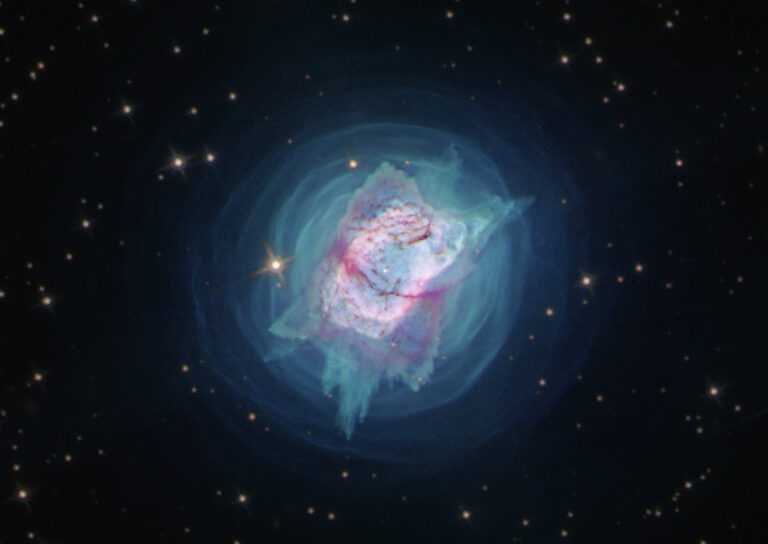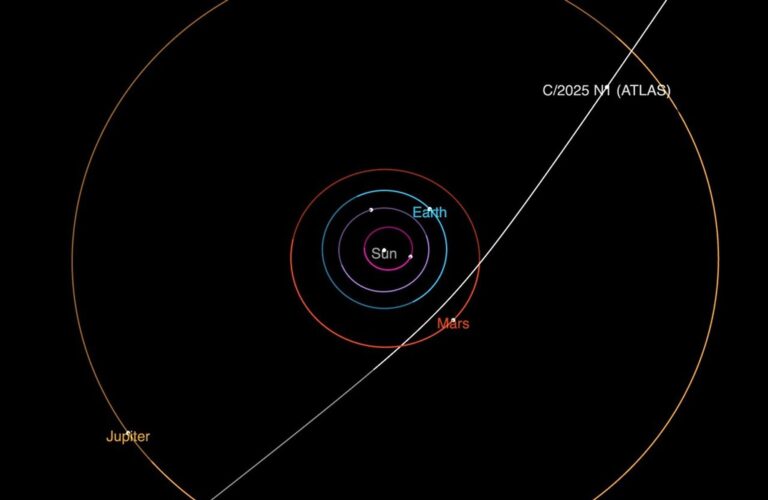Key Takeaways:
Using computer models, astrophysicists from the Rochester Institute of Technology (RIT) in New York and Johns Hopkins University in Baltimore, Maryland, are tracing electromagnetic signatures back to the impact. They are creating a detailed blueprint that will guide other scientists searching for merging black holes, using ordinary visible light and existing telescopes. Simulated models of these mergers will also aid the discovery of gravitational waves, confirming a key prediction of Einstein’s general theory of relativity.
The team, led by Manuela Campanelli from RIT, has won a $2 million grant from the cyber-enabled discovery and innovation program of the National Science Foundation. Julian Krolik is leading the collaboration’s efforts at Johns Hopkins. Both institutions received $1 million awards for the 5-year project.
The scientists will use computer models to simulate what happens to an accretion disk — a doughnut-shaped ring of gas and dust — as a pair of black holes within it approach each other and merge. According to Campanelli, the surrounding gas and dust mixture is heated and will likely produce electromagnetic radiation — light — that could be detected with conventional telescopes, such as the Large Synoptic Survey Telescope, even before sufficiently sensitive gravitational wave telescopes are built.
“By being able to model this for the first time in a realistic scenario, with realistic conditions, we should be able to predict signals of binary black hole mergers that can be seen in the electromagnetic sky,” said Campanelli. “It’s a big deal because nobody has ever attempted a consistent and long-term project to model such a phenomenon.”
“The goal is to get a very accurate and consistent model of the electromagnetic emission from something that is also emitting strong gravitational waves,” said Scott Noble from RIT. “And I think the significance of the project is that we’re doing this in a very careful, methodical way.”
“Our project will make use of combined expertise in the simulation of generic black hole binaries with magneto-hydrodynamics simulations to model the accretion disk physics during the last phases of the binary,” said Yosef Zlochower from RIT, “when both space and time are very dynamical.”
The problem requires solving the equations describing the behavior of ionized gases threaded by magnetic fields along with the equations comprising Einstein’s general theory of relativity, Campanelli said. Looking at binary black hole mergers through complementary signals — gravitational waves and electromagnetic waves — introduces a new type of astronomy.
“From the electromagnetic radiation, you can clearly determine direction,” Campanelli said. “We’d be able to connect a lot of the physics happening within the gaseous environment and accretion disk to the binary black hole merger to the gravitational radiation. It will be multi-messenger astronomy because it’s electromagnetic combined with gravitational radiation.”
Krolik’s team at Johns Hopkins will model the premerger stage of the binary black holes using Newton’s law of gravity to describe masses that are far apart. Campanelli’s group at RIT will look at what happens when Newtonian physics breaks down and the black holes draw closer together and actually merge. Both teams will address the post-merger physics.
“We want to marry the two regimes and use the far-field results to feed into the close-field results to get a consistent picture of how these systems evolved in time,” Noble said.
The multilayered problem describes various stages of the merger in gaseous environments. Both teams are trying to “connect the dots” in this massive problem that draws on gravitational radiation and magneto-hydrodynamics, the theory that governs the dynamics of gas or plasma in strongly gravitating systems.
“The effort is therefore strongly multidisciplinary because of the multiple kinds of expertise needed: numerical relativity; magneto-hydrodynamical simulation; advanced computational techniques, including parallel computing; the use of very large data sets; scientific visualization; and observational astronomy,” Campanelli said.
“It’s a very challenging computational problem,” she said. “It’s huge. If you think of how complicated these black hole coalescences are without any gas or electric fields, you can imagine — when you add electromagnetic radiation and gas — that we will have very demanding simulations.”
Simulating the merger of binary black holes in gaseous environments requires access to considerable computer power. The RIT team will run the actual merger on its own computer, NewHorizons, and make use of additional resources.
“The project will generate a much larger amount of data than we are currently generating,” said Lousto from RIT. “Money allocated in the grant will add 200 terabytes of storage and processing power to the center’s computer.”
Using computer models, astrophysicists from the Rochester Institute of Technology (RIT) in New York and Johns Hopkins University in Baltimore, Maryland, are tracing electromagnetic signatures back to the impact. They are creating a detailed blueprint that will guide other scientists searching for merging black holes, using ordinary visible light and existing telescopes. Simulated models of these mergers will also aid the discovery of gravitational waves, confirming a key prediction of Einstein’s general theory of relativity.
The team, led by Manuela Campanelli from RIT, has won a $2 million grant from the cyber-enabled discovery and innovation program of the National Science Foundation. Julian Krolik is leading the collaboration’s efforts at Johns Hopkins. Both institutions received $1 million awards for the 5-year project.
The scientists will use computer models to simulate what happens to an accretion disk — a doughnut-shaped ring of gas and dust — as a pair of black holes within it approach each other and merge. According to Campanelli, the surrounding gas and dust mixture is heated and will likely produce electromagnetic radiation — light — that could be detected with conventional telescopes, such as the Large Synoptic Survey Telescope, even before sufficiently sensitive gravitational wave telescopes are built.
“By being able to model this for the first time in a realistic scenario, with realistic conditions, we should be able to predict signals of binary black hole mergers that can be seen in the electromagnetic sky,” said Campanelli. “It’s a big deal because nobody has ever attempted a consistent and long-term project to model such a phenomenon.”
“The goal is to get a very accurate and consistent model of the electromagnetic emission from something that is also emitting strong gravitational waves,” said Scott Noble from RIT. “And I think the significance of the project is that we’re doing this in a very careful, methodical way.”
“Our project will make use of combined expertise in the simulation of generic black hole binaries with magneto-hydrodynamics simulations to model the accretion disk physics during the last phases of the binary,” said Yosef Zlochower from RIT, “when both space and time are very dynamical.”
The problem requires solving the equations describing the behavior of ionized gases threaded by magnetic fields along with the equations comprising Einstein’s general theory of relativity, Campanelli said. Looking at binary black hole mergers through complementary signals — gravitational waves and electromagnetic waves — introduces a new type of astronomy.
“From the electromagnetic radiation, you can clearly determine direction,” Campanelli said. “We’d be able to connect a lot of the physics happening within the gaseous environment and accretion disk to the binary black hole merger to the gravitational radiation. It will be multi-messenger astronomy because it’s electromagnetic combined with gravitational radiation.”
Krolik’s team at Johns Hopkins will model the premerger stage of the binary black holes using Newton’s law of gravity to describe masses that are far apart. Campanelli’s group at RIT will look at what happens when Newtonian physics breaks down and the black holes draw closer together and actually merge. Both teams will address the post-merger physics.
“We want to marry the two regimes and use the far-field results to feed into the close-field results to get a consistent picture of how these systems evolved in time,” Noble said.
The multilayered problem describes various stages of the merger in gaseous environments. Both teams are trying to “connect the dots” in this massive problem that draws on gravitational radiation and magneto-hydrodynamics, the theory that governs the dynamics of gas or plasma in strongly gravitating systems.
“The effort is therefore strongly multidisciplinary because of the multiple kinds of expertise needed: numerical relativity; magneto-hydrodynamical simulation; advanced computational techniques, including parallel computing; the use of very large data sets; scientific visualization; and observational astronomy,” Campanelli said.
“It’s a very challenging computational problem,” she said. “It’s huge. If you think of how complicated these black hole coalescences are without any gas or electric fields, you can imagine — when you add electromagnetic radiation and gas — that we will have very demanding simulations.”
Simulating the merger of binary black holes in gaseous environments requires access to considerable computer power. The RIT team will run the actual merger on its own computer, NewHorizons, and make use of additional resources.
“The project will generate a much larger amount of data than we are currently generating,” said Lousto from RIT. “Money allocated in the grant will add 200 terabytes of storage and processing power to the center’s computer.”









